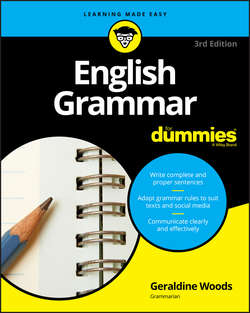Читать книгу English Grammar For Dummies - Woods Geraldine - Страница 11
Part 1
Building a Firm Foundation: The Parts of the Sentence
Chapter 2
Verbs: The Heart of the Sentence
Expressing Meaning with Verbs
ОглавлениеWhat time is it? You can find out by checking a clock, your watch, your phone, or a verb. Surprised by that last one? Verbs express states of being (what is, was, or will be) and action (what someone or something does, did, or will do). In other words, a verb is a part of speech that expresses time, which grammarians call tense. Check out the italicized verbs in these example sentences. Notice what the verb tells the reader or listener about time:
Mark spilled ink on the quilt. (spilled — past)
Mark’s mom is upset. (is — present)
Mark will wash the quilt, or his mom will murder him. (will wash and will murder – future)
These are just three simple examples, but you get the point. The verb puts the action or state of being on a time line. (Don’t tense up about tense. You can find everything you need to know about this topic in Chapter 6.)
One more important thing you should know about verbs: In a sentence, the verb must match the subject, the person or thing performing the action or existing in the state of being. (See Chapter 3 for the lowdown on subjects.) If the subject is singular (just one), the verb is singular. If the subject is plural (more than one), the verb is plural. In these example sentences, the subject is in bold type and the verb is italicized:
The poster is on the wall of Sam’s bedroom. (poster and is — singular)
Sam’s pets hate the poster. (pets and hate — plural)
Sam’s cat has chewed one corner of the poster. (cat and has chewed — singular)
My well-behaved dogs do not chew posters. (dogs and do chew – plural)
In the last example sentence, did you notice that the word not isn’t italicized? Not changes the meaning of the verb from positive to negative, but it isn’t an official part of the verb. It’s an adverb, if you really want to know. (Turn to Chapter 10 for more about adverbs.)
For help with matching singular subjects to singular verbs and plural subjects to plural verbs, read Chapter 7.
